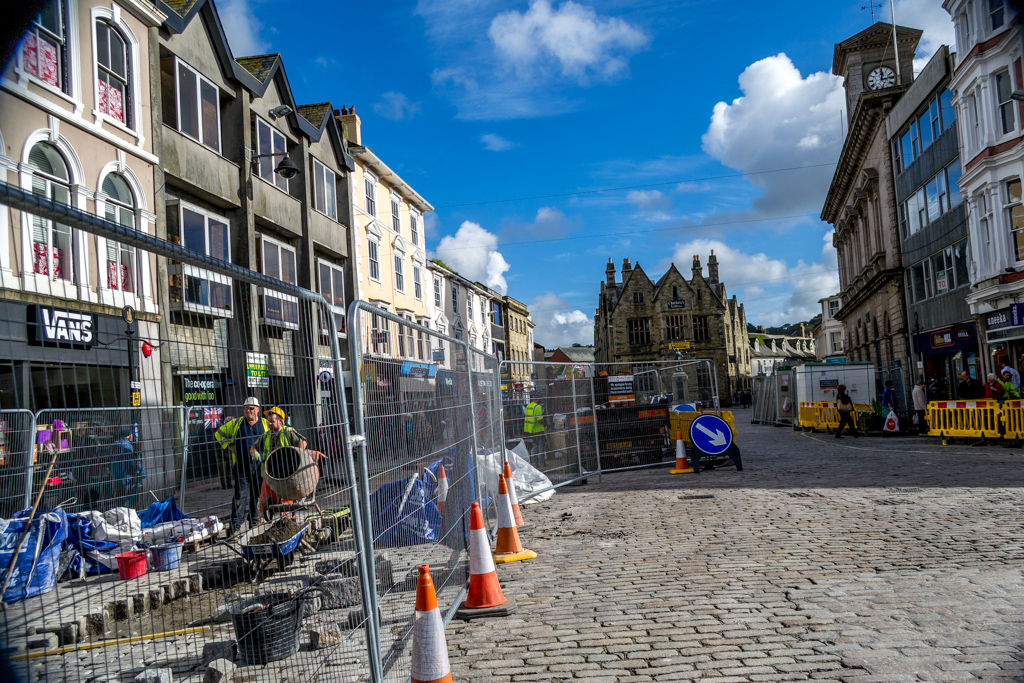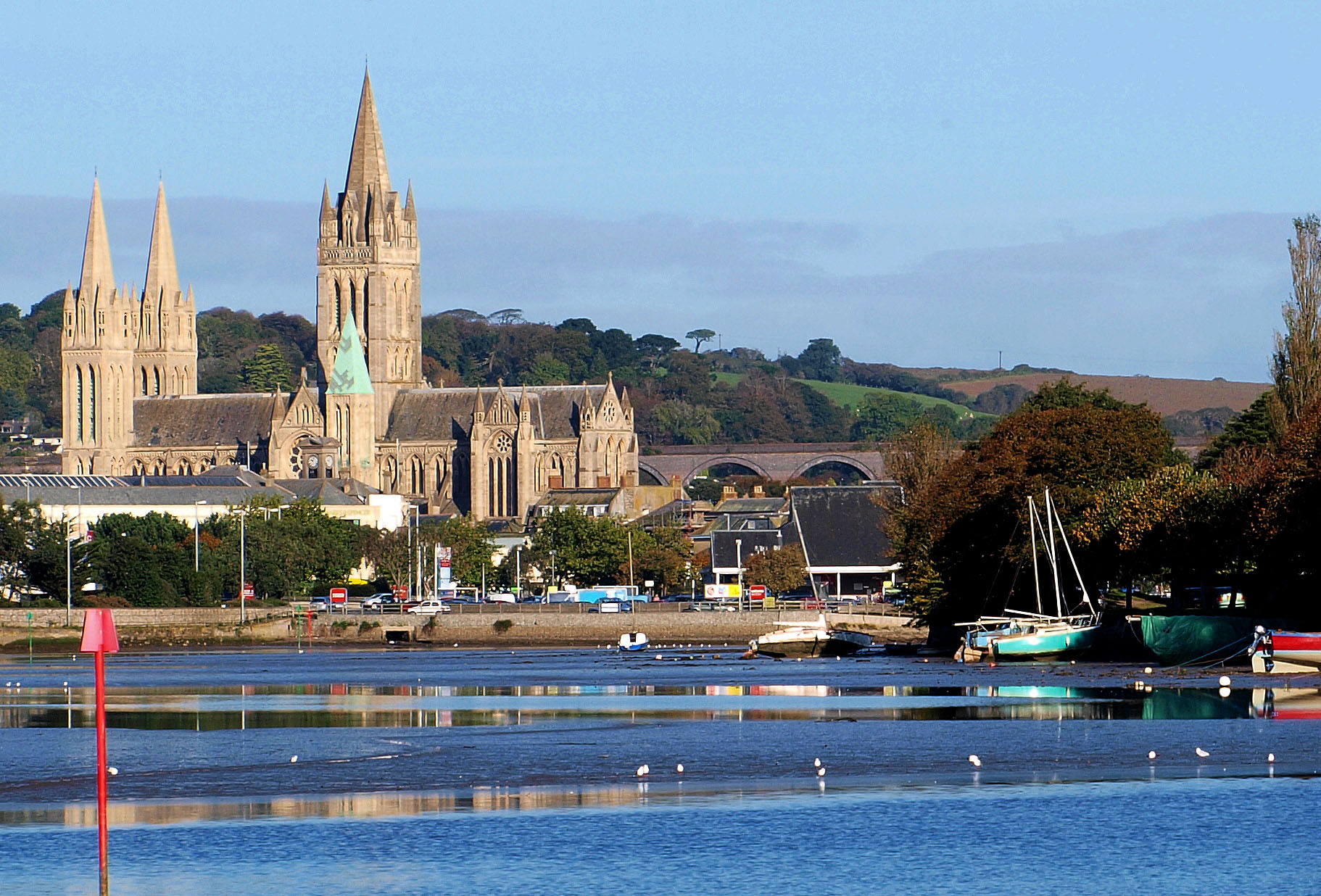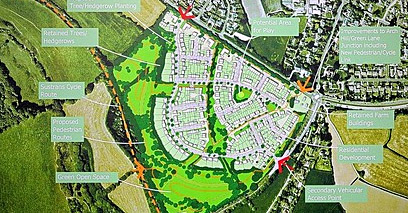Of Stadiums, Supermarkets and Sewage
The big news this month is the latest round in the battle to build at Threemilestone. Thursday 12th March saw four major applications and Truro City Football Club put before a marathon Strategic Planning Committee. The agenda (with supplements) was in the region of 3” – 4” thick. The meeting ended after 11 hours with catering provided to members by the Vice Chairman, for which the members paid. Rob Nolan did an exceptional job in chairing the meeting. He was calm, efficient, organised and authoritative.
The media devoted itself to puffing up the stadium issue. The stadium was granted planning consent some time ago but since then the site has been designated by Cornwall Council as open space. It did not form any element of any application and yet it excited contributions from West Cornwall members who paid no heed to material matters relating to the planning applications but instead rhetorically ‘campaigned’ for the application which said in its supporting material that it would facilitate a stadium.
We have discussed the Stadium before. As you know, I favour the provision of a viable sports and entertainment arena close to Newquay airport, which would enable the offer of an enhanced holiday experience in addition to the stadium event, and would enable the airport to play the key role in audience development on a potentially European scale – the best way to fill seats, and, of course, the best way to be viable. Intelligent marketing is the essential practice which underpins such venues, and revenue generation is important because people tend to wear buildings out quickly – as, in deed, Truro College knows only too well.
I was very surprised to find Truro College playing such an active role in speculative property development proposals in Truro when they have such a large estate to maintain, much of which was built within the same decade and which will see, as a result, all buildings at the same point in the maintenance cycle at the same time – an expensive prospect for buildings which, with such intense usage, have a relatively short life-span. If you know the day on which it’s going to rain then it’s probably best to start saving early! In addition, Truro College has development proposals elsewhere, especially in North Cornwall, which have a greater relevance to the College’s core business, as well as a new campus at Penzance to sustain. Setting up liabilities on the other side of an arterial strategic road seems a very odd way of planning for future resilience.
I was also surprised to find Truro Chamber of Commerce advocating for an application (West Langarth) which includes not only yet another supermarket but also provision for a group of durable goods shops as well – direct competition to the town centre. The stadium was the lure, even though it is predicated upon diverting the purpose of the Langarth park and ride from being the key traffic management measure to ease congestion on the Highertown corridor, and secondarily, to reduce on-street commuter parking in the central area of Truro, to being used as the stadium car park (and presumably the car park for the conference centre, catering school, offices etc which is required to bolster the stadium business plan. The Chamber acknowledged that the West Langarth application would reduce town centre trade but suggested (with no figures to support their case) that town centre trade linked to the stadium would offset any loss.
I find this a very difficult notion. If vehicles going to the stadium park at the park and ride, then vehicles seeking the park and ride in order to go on into town will be displaced. At the same time, any overspill from the stadium (eg a rugby fan’s spouse) would be only a relatively few of the prop-osed 6000 capacity crowd. If the park and ride is utilised to service the stadium then there would be little point in running the park and ride buses, so how would the occasional spouse-customer get into town? Would they not either stay at home and shop by internet, or shop at West Langarth and hen wait? In the event, the Chamber’s comments had a profound influence on the Strategic Planning Committee. With the distance between Truro town centre and Threemilestone it is not easy to see how there will be causal trade benefits arising from a stadium sufficient to offset the provision of a supermarket and durables shopping, especially when the likelihood of a stadium being supplied is not dependent upon any of the applications being consented – that is, not conditional!
Therefore, the material factor for the committee to weigh is the impact of calculated trade loss from the proposed retail provision, and not any theoretical offsets which may emanate from a non-obligatory sports arena.
The second thing about the stadium is the degree to which the proposition has shrunk from an original 10,000 seats down to a sports pitch with a single stand capable of about 6000 seats, with the possibility of more to follow if there is demand. This is not that much better than looking at the potential of Truro City Football Ground if good seating was installed on all four sides of the existing pitch – with the added advantage of a direct walking-distance link to the railway station as well as pedestrian potential (about ten minutes) between the football ground and the town centre.
Nonetheless, the Truro Chamber of Commerce not only quietly supported the Stadium in an initial letter, but strengthened this significantly in a subsequent letter. This seems a quite eccentric way for an association of town centre traders to defend their interests!
As it turned out, the Strategic Planning Committee decided to grant consent to Maiden Green and to Willow Green – this means a substantial volume of housing along with two supermarkets. This is despite the Council’s own retail consultants (GVA Grimley) advising that one supermarket was required, and that this would result in trade loss, but to a degree which was sustainable when the supermarket met demand from the new housing provision and alleviated traffic to enable easier (relatively speaking) access along the A390 to the town centre. A third application (Hendra) which does not involve housing, was deferred, together with the West Langarth application – neither deferral is to assess the cumulative retail impact of the committee’s decisions so far.
So, we are in uncharted territory with the town centre now at risk of suffering significant trade loss to add to that already envisaged from the Waitrose development. There is much confusion around the manner in which sequential testing has been done, and what the outcomes are of such tests. In trading terms, and with a major application deferred, it seems that, far from planning a measured response to development pressures and consumer demand, the planning committee is seeking to unleash a commercial assault upon the town centre. The public pressure to consent West Langarth because this is the application which has created the impression that, if granted, the developer will pay for the stadium, is intense.
We saw Councillors from Penzance and Porthleven strongly advocating such a consent no matter the material consequences for the town centre. It is surprising to find Penzance members advocating the export of their own rugby team, but then, common sense and proportionality seem to have departed the debate on this occasion. It is equally difficult to find members from other towns which are struggling with the trade impacts of recently developed multiple supermarkets coming to the planning committee (although they have the right to do so) to argue in favour of an application which is a risk to the vitality and viability of Truro because it has been publicised as being a facilitating development for a stadium which has no business plan, no site and no investment. It reminds me of ramblers in Northumberland talking-out a parliamentary bill to secure a Commoners’ Council for Bodmin Moor!
It is very difficult to see, from either the committee reports or the content of the meeting, a commitment to ensure that, before development occurs, the access road through the assembled mega-estate to the hospital is secure. To rely upon a piecemeal approach with several applications, some recommended for refusal, others for approval, to supply incremental parts of the key infrastructural provision is, in my view, both incomprehensible and irresponsible. The way in which transport matters are dealt with by the Planning Department in relation to applications of all sorts is unsatisfactory and is producing an ever-growing list of problems for the future – the whole point of planning must surely be to envisage problems and to mitigate them. To plan with systems and tools that are insufficient to the job of securing an efficient future life for infrastructure is foolish – even Neolithic tribes selecting sites for stone circles did better – much better – than this.
And so, inevitably, we turn to sewage!
This is a quote from a report by consultants retained by the applicant at West Langarth. It does not, as far as I am aware, differ materially from similar statements relating to the other applications which include housing.
There are currently no gravity sewers or foul rising mains in the direct vicinity of the proposed development site. The closest option for dealing with the foul water flows generated by the development would be to drain to Hullbullock Moor (located approximately 3km to the southeast).From here the flow flows can drain by gravity to the main Calenick pumping station, and then on to the Truro treatment works.
In the committee papers it was very clear that South West Water (SWW), the private company which operates a contract to be the Water Board and is, thereby, the ‘Statutory Undertaker’ responsible for sewage collection, conveyance, treatment and disposal, has sufficient capacity at the existing Newham Sewage Treatment Works to accommodate the outpourings of 40 dwellings. After this figure is reached, works will be required.
Whilst it is the duty of SWW to respond to demands generated by development, the rates it levies (which are, technically speaking, a tax levy, the non-payment of which can result in imprisonment), in my view, should not be calculated to provide such a surplus as to enable reserves to facilitate infrastructure provision for private developers, even though the eventual residents’ water rates could be top-sliced for many years to secure repayment of capital investment. Why should water-rate payers, present or future, pay to meet the obligations of private developers who will only take more profit from reduced costs of infrastructure provision. If business deals are being done between the statutory undertaker and a developer then I believe the details of these should be revealed as part of the planning process and that the statutory undertaker should be fully accountable to its rate payers in the same way as the Cornwall Housing Company is accountable to its tenants for how it spends their rents and, indeed, what rents should be charged.
SWW claim to be accountable only to its shareholders, but, under the franchise it holds, it should be accountable to its customers (water rate payers). If the franchise is being used as a means to set up and broker private deals with developers then, in my view, this is an abuse of the public trust which should underwrite the operation of public services, especially where these have a critical effect upon public health and wellbeing.
Two facts:-
That the housing developments at Threemilestone (or ‘Fourmilestone’, as certain people call it!) all rely upon pumps and sumps to transport sewage from the S bend to the treatment works;
That sewage will be required to travel long distances to get to the treatment works –
dictate that the planners need to be fully assured that the risks – of leakage, slow pace, chemical change, toxicity and infection – are less than minimal, that the system can operate despite the vagaries of human frailty (by relying on gravity, not machinery), and that quality of treatment is sufficient to remove all harmful elements from treated material before discharge.
The triumph of our society is that, by successfully managing sewage, we have achieved environmental conditions which enable good lives to be lived to advanced ages by very many people, and that the scourges of epidemic infections traceable to bad water supplies and poor sewage management have been virtually eliminated from our social environment. The line between good management and failure is a very thin one, in need of constant vigilance and the support of high standards of development control coupled with good design and consistent education.
With the developments now either consented or proposed, and with a treatment works at Newham which is evidently under pressure (no matter what its operators say), and with transport lines now so long and flow-rates so slow (because Truro and Newham are at sea level), and with increasing reliance upon machines to move toxic materials from toilet to treatment, the risks are increasing, not reducing – and this is not good planning.
The contents of committee reports, the assertions of officers, the lack of interrogation by members, all conspire to raise the spectre of system overload and failure – and all because distant policy makers have staked their reputations upon quick volume development at the expense of method, care and quality. No matter what the rules say, I strongly believe that, as citizens, we should demand diligent attention to the detail of sewage management, and that no application should be processed unless there is full disclosure of proposed systems, the guarantee of funds to pay for it, and the undertaking that no development will occur until the infrastructure is complete and tested. Without this OUR society is at risk, and all that has occurred is that greater profits will be taken whilst the public purse is left to meet the costs of amelioration and repair.
We must then ask – yet again – why the planning system is so lacklustre in defending good quality agricultural land.
Time and again the grade of land is ignored, expediency is applied and, in some cases, efforts are made to reclassify (without using the requisite procedure). The amount of good land which is now being sacrificed in the gallop to meet outlandish quotas (as declared by Government, Local Plans, pressure groups (eg National Housebuilders Federation, the late and unlamented RDA) is verging on the catastrophic. The loss of capacity in food production may seem of little consequence now, but in fifty years – half the life span of a modern dwelling – with climate change gathering pace, aridification advancing and reliance on the temperate zone for food production, this surrender of capacity will be viewed much differently. To conduct a planning process which does not give sufficient weight to the value of agricultural land belies the use of the noun, ‘system’ – it is more like the facilitation of irresponsible asset consumption for short-term gratification – bad social management, poor husbandry and a practice ignorant of the complexity and quality of development (a different sort of development, but development nonetheless) required to make a good field.
At Three/Fourmilestone we are seeing a quite cavalier disregard – not of the scandalous degree we saw at Tregurra – but still, a sufficient disregard to raise serious questions about the rules being applied. In the end, if the rules are wrong, and the rule-makers are deaf to the need for reform, then we need to step-up resistance. I believe that Cornwall Council is a body of sufficient scale and weight to be raising this urgent and critical matter with the Government at the highest level. Cornwall, and Truro in particular, is at the point where crucial balances are being tipped towards abandonment of essential capacities and assets to stimulate the profit curves of exploiters, speculators and others for whom society is more of a ‘market’ than a responsibility.
We are seeing prima facie evidence of this at Threemilestone. The supermarket as a distribution concept is not only a reductive customer of the agricultural industry, but also a consumption-driven generator of profligate carbon footprints, especially in Cornwall, where peripherality makes supply a carbon-expensive business. Self-sufficiency is not a hippy ideal when climate change is altering the parameters of survival. We have significant choices to make, and the system we see being applied here, and the professional expediency being applied, all militate towards failure and socio-environmental deterioration. This should all be telling us ‘Enough is enough’!
Leading academics are now challenging the ability of the planet or society to continue to sustain a growth economy. Our intuition and experience tell us that we have over-reached ourselves. It is time for our new substantial democratic assembly, Cornwall Council, to stand up and represent its community in its fight for the right to conserve its sustainable assets – the land.
Bert Biscoe





